BEST Breastfeeding DIET CHART FOR LACTATING MOTHERS
It’s no secret that the newborn baby derives all the nutrition from the mother’s milk. So, the mother’s nutrition and diet are equally important to the baby, if not more. Whatever the mother eats is being utilized in lactation. So having a wholesome diet becomes more important during this time than ever in a woman’s life. Women search on the internet for ‘lactating mother’s diet chart’ and get lost for hours, without gathering some solid information in the end. Budding Star would like to end the confusion, once and for all. We are sharing a chart diet for lactating mothers in India. This vegetarian diet plan for breastfeeding mothers is easy to follow and includes food items that are easily available in your kitchen.
Foods to Include in Indian Breastfeeding Mom Diet
Foods to Avoid in Indian Diet Plan for Breastfeeding diet chart Mothers
Breastfeeding Diet India– Plan For Mothers
This article is for new Mothers who breastfeed their babies and for To-be Mothers. The post describes the Indian Diet Plan for Breastfeeding Mothers. Nowadays, most mothers opt to breastfeed as breast milk provides the best nutrition for the baby. Even WHO recommends that breast milk should be continued to be part of a child’s diet, up to 2 years of age and beyond. Before describing the Food chart for breastfeeding mothers and a postpartum diet plan while breastfeeding, let’s read about the benefits of breastfeeding.
It’s no secret that the newborn baby derives all the nutrition from the mother’s milk. So, the mother’s nutrition and diet are equally important to the baby, if not more. Whatever the mother eats is being utilized in lactation. So having a wholesome diet becomes more important during this time than ever in a woman’s life. Women search on the internet for ‘lactating mother’s diet chart’ and get lost for hours, without gathering some solid information in the end. Budding Star would like to end the confusion, once and for all.
Benefits of breastfeeding a baby:
Some of the benefits that babies get from breastfeeding are as follows:
- Breast milk contains all the nutrients the infant needs for proper growth and development.
- It promotes brain development in babies.
- Breast milk is a great way to improve and increase immunity in kids because it contains antibodies and white blood cells, which boost the immune system and help the body fight against diseases.
- It also helps Mothers in shedding their post–pregnancy weight more easily.
Thus, it is recommended to breastfeed a baby for at least up to 6 months. It can be extended along with a solid diet, and it is no harm if one pursues breastfeeding up to 2 years of age and beyond. Do remember Moms! Your baby’s growth is the utmost thing and it all depends on you. So, go ahead and nurse your baby for as long as it feels right to you. The longer you breastfeed, the greater the protective effects.
We all know that whatever a mother eats as her food, a baby can taste it in her milk. So, in a way, a baby eats whatever goes in his/her mother’s tummy. Thus, a breastfeeding mother needs to be very cautious about her diet. But it doesn’t mean that anything you eat or drink while breastfeeding can cause colic (indigestion) in your baby. There could be many other reasons for colic like if your baby is not latching on well, swallowing milk too fast, and inhaling too much air. Hence, we recommend protein-rich foods for lactating mothers.
Before penning down the Indian Diet Plan for Breastfeeding mothers, let us first find the list of foods that you should include and avoid while Breastfeeding.
Calories Needed for Breastfeeding Mothers
Foods to include in indian breastfeeding mom diet:
Those days are gone now when a mother was made to eat khichdi and porridges for months post-delivery. But now, the diet plan for lactating mothers includes all the best parts of the traditional and modern diet. Let’s find out a list of foods that can be included in the Indian Diet Plan for Breastfeeding mothers.
So, here’s an Indian diet chart for lactating mothers:
1. Proteins:
Add Masoor dal, green moong dal, paneer, and kidney beans to your diet if you want protein in your diet. If you are looking for a vegetarian diet plan for lactating mothers, pulses have to be there. Every postpartum Indian diet during breastfeeding should have protein in it.
Non-vegetarian mothers can include eggs, fish, and boiled chicken as per their preference. All include a lot of protein to nourish and support your baby’s growth and to have a steady supply of milk.
*Avoid curd in the first two months after delivery and can start consuming it from 3rd month onwards.

2. Liquids:
When you breastfeed, your body experiences plenty of loss of fluids as breast milk comprises 90% water. To make up for this loss, a lactating mother should consume enough liquids. You should have at least 8 glasses of water in a day. Intake of liquids also helps in milk production. If it is not enough, it may lead to dehydration, lesser milk production, constipation, dry skin, etc.
You can take water (fennel seeds, ajwain), coconut water, vegetable soups, spinach soup (a good source of iron), bottle gourd, beetroot, and carrot juice (a good source of iron). To quench your thirst, add mint or strawberry to your regular water. You can include vegetables and fruits like watermelon that have high water content in your diet.
You can have herbal teas with safe ingredients like fennel seeds, ajwain, black pepper, etc. It helps in proper digestion and sheds some fat also.
*It is recommended to drink liquid half an hour prior before breastfeeding your baby as it makes you thirstier.

3. Whole grains:
They provide essential minerals that are necessary for you and your growing baby. Also, it is an easy food to digest for lactating mothers.
You can include whole wheat flour, oats, Porridge (daliya), brown rice, quinoa, ragi, muesli, khichdi, etc. in your diet chart.
* You can use sprouted grains in place of usual dry grains as they are much healthier. Try Wheat/Ragi/Bajra/Jowar. Make flour of sprouted and dried grains and use it for making porridge.
4. Iron:
You need to replenish your iron stores in the body after delivery. So, it is essential to include iron–rich foods in the Indian Diet Plan for Breastfeeding Mothers.
Vegetarian Mothers can have dry beans, turnip greens, kale, black–eyed peas, green leafy vegetables, wholegrain bread & cereals, and green peas. If you cook food in iron vessels with tomatoes, this can also provide some iron content. Almonds and walnuts are again good sources. Jaggery is a good source too.
Non-vegetarian Mothers can have liver and organ meat of chicken, meat for replenishing iron content in the body.
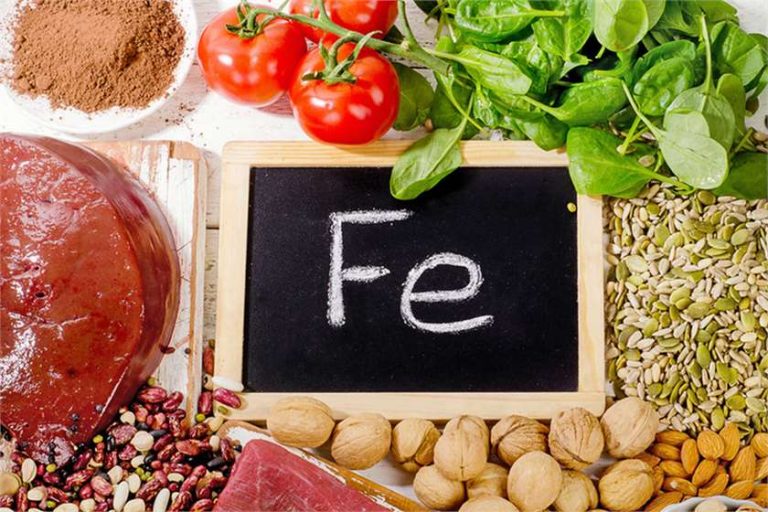
5. Vitamins:
Vitamins help in developing a baby’s growth and boost milk production. The diet plan for lactating/breastfeeding mothers should include lots of green vegetables and fruits. You can have bottle gourd, spinach, fenugreek, pumpkins, Tinda, carrots, and beetroots. Fruits like apples, pears, pomegranates, papaya, etc. should be included in your diet. Nursing mothers need more amounts of Vitamin C so a diet filled with strawberries, broccoli, and potatoes.
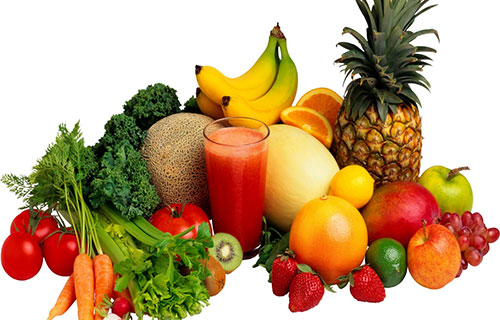
6. Calcium:
This nutrient is very crucial for the right growth of a baby’s bones hence, it should have a place in the diet chart of a breastfeeding mother. Calcium is found in spinach, kale, and mustard greens as well as turnip tops. Milk and all milk-based products like paneer are also durable in an Indian diet for breastfeeding mothers.
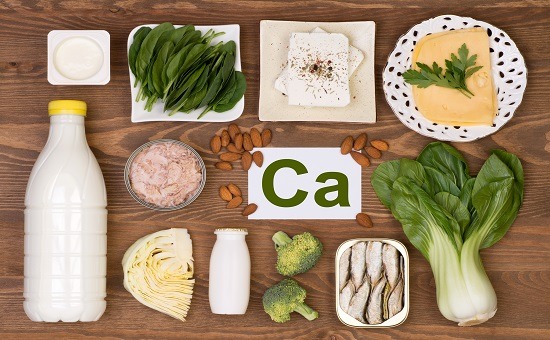
7. Galactagogues Food:
These are the foods that are a must because they boost milk production in a lactating mother. You can get good milk production if you eat chickpeas, papaya, whole grains, and legumes as a part of the diet plan of lactating mothers.
A good diet also means a break for exhausted mommy’s secrets of a happy mother that is not emphasized enough for some reason. Breastfeeding can be easy for one mother but difficult for another, it depends, and hence one of the biggest motherhood challenges.
8. Vegetables:
Certainly, a vegetarian postpartum diet plan for mothers while breastfeeding includes vegetables. Strive to add vegetables into your diet at least including three servings of vegetables. Each day add some dark green and yellow vegetables because they are rich in vitamins, nutrients, and antioxidants. By consuming these vegetables sufficiently, your body will replenish the nutrients for breastfeeding and keep you healthy as well.
9. Fruits:
Not only are fruits delicious, but they are also one of the most nutrient-dense foods. By including at least two servings of fruit daily, you can help to nourish yourself and your baby. Mothers need nutrition for lactating, and fruits have essential minerals, vitamins, and fibre. Some foods are superfoods for breastfeeding which can keep you hydrated and increase your breastmilk.
10. Nuts and Seeds:
Striving to include nuts and seeds in your diet can be a good source of iron and zinc. Add dried fruits, seeds, nuts, dried beans, and even dairy in your daily diet to top up all your depleting nutrients. Almonds are great for lactating mothers because they are a rich source of calcium.
What should a lactating mother eat?
Here are some of the best foods for lactating mothers to include in their diet.
- A mother should include protein foods like meat, chicken, fish, eggs, dairy, beans, nuts, and seeds.
- She must intake three servings of vegetables, including dark green vegetables each day.
- She should eat seasonal fruits per day.
- She must add whole grains such as wheat bread, wheat pasta, cereal, and oatmeal to her diet plan.
- She must drink plenty of water and fluids.
- Vegetarian diets are a good option for breastfeeding mothers. If you don’t eat meat then you can add other sources of iron and zinc to your diet. Add beans, nuts, seeds, and dairy products. You can also intake B12 supplements to avoid any deficiency.
How Much Quantity to Intake?
While breastfeeding, mothers need extra calories. A diet plan for lactating mother ensures there is enough quantity of calories that is recommended for them. Make sure to take the amount suggested to produce a healthy supply of milk. Babies also need calories to grow healthier. These calories will naturally be taken by the babies from the mother’s milk only. You can cut your calorie intake when your baby starts eating solid foods.
Mothers Should Avoid Alcohol and Caffeine
The best way to give your baby a healthy life is to avoid intake of alcohol but still, if you wish to have drinks then wait for at least 3 hours after each serving before feeding your baby. After 3 hours alcohol levels go down so, it is gone from your milk too.
Caffeine is also bad for your and your baby’s health. If your baby is asleep and feeling irritated that means you have to avoid caffeine intake.
Food mothers must increase
In order to increase your breast milk production, you need to increase the intake of protein present in meat, chicken, eggs, lentils, fish, legumes, and healthy fats present in olive oil, nuts, fruits, oily fish, and dried seeds. To ensure good health for yourself and your baby, oily fish is a good option to go with.
Recipes to Increase Production of Breast Milk:
Here are some recipes for mothers to try out when they’re lactating.
- Pumpkin spice Smoothie for lactation diet chart
This delicious smoothie is packed with nutritional values which will naturally boost your milk supply.
Ingredients:
- 1 ½ cups unsweetened coconut milk (or other milk of choice)
- 1 tablespoon pumpkin puree (canned or fresh)
- 1 carrot (chopped)
- 1/2 cup mango (fresh or frozen)
- 1 teaspoon vanilla extract
- 1/2 teaspoon cinnamon
- 1/4 teaspoon nutmeg
- 1/8 teaspoon ginger
- 1/8 teaspoon cloves
- 1 tablespoon collagen peptides (optional)
- Honey (or other desired sweetener) to taste (optional)
- Handful of ice cubes (optional)
Directions:
- In a blender or food processor add all the ingredients
- Blend it until a creamy and smooth consistency occurs
- You can add coconut whipped cream or crushed walnuts (optional)
- Drink it!
- Overnight Oats for lactation diet chart:
A versatile recipe that is a great option for working or busy moms. You can add nutritional toppings like walnuts, chia seeds, or fresh fruits.
Ingredients:
- ½ Cup Rolled Oats
- 1 Cup Milk of Choice (Almond, Soy, etc)
- 1 tsp Cinnamon
- ½ tsp Pure Vanilla Extract
- 2 Tbsp nuts/seeds (almond slices, walnuts, etc)
- 1-2 Tbsp sweetener of choice (such as honey, maple or agave syrup)
- Optional add-in ingredients: Fresh fruit, chia and/or flax seeds, nut butter, dark chocolate, or cocoa powder
- 1 clean jar with lid
Directions:
- Take a jar and mix it with all the ingredients and if you want to put any add–ins. Stir it until completely combined. Cover the jar with the lid and leave it overnight.
- Eat it with your favorite accompaniment like healthy milk, fresh fruits, ground nuts, etc that you prefer. Enjoy!
- Vegetable Pulao
This dish is absolutely yummy and is infused with the goodness of different vegetables which is highly nutritious for new moms.
Ingredients: 2 cups of basmati rice, 1 tablespoon of ginger-garlic paste, 1 onion (chopped), 1 cup of mixed vegetables, chopped (beans, carrots, peas, cauliflower), 2 tomatoes (chopped), Green chilies as per choice, Mint leaves (optional), Salt to taste, Ghee, Water (4 cups), 1 teaspoon of cumin seeds, Cardamom, Bay leaves, Cloves, Cinnamon stick (1/2 inch in size), and Raisins and cashew nuts to decorate (optional).
Directions:
- Soak the basmati rice for 15 minutes.
- Heat the ghee in your pot/cooker and add your spices (bay leaves, cardamom, cumin seeds, cloves, cinnamon stick).
- Add some ginger-garlic paste and let it sauté.
- Add the chopped onion, vegetables, and chopped tomatoes after.
- Let the vegetables cook for 5 minutes and add the rice.
- Add some mint leaves, salt and water.
- Stir and let it cook on low heat until the water evaporates and the rice is cooked.
- Garnish with raisins and cashew nuts.
- Super Paratha
This paratha is stuffed and is an easy dinner recipe that you can enjoy with some raita or any curry.
Ingredients: 1 cup of cooked moong dal or any other dal, 1 cup of whole wheat flour, 1/2 cup rice flour, 1/2 cup powdered oats, 1/2 cup Besan (gram flour), 1/2 cup grated bottle gourd, 1/2 cup grated carrots, and salt to taste.
Directions:
- Mix the flour (rice flour, wheat flour, gram flour) and powdered oats well.
- Add the dal of your choosing, grated bottle gourd, and grated carrot.
- Knead into a smooth dough and make parathas.
- Vegetable Soup
This soup is very healthy and the ideal comfort food that you can keep and reheat!
Ingredients: 1 large pumpkin, 2 carrots, 1 onion, 5 cloves of garlic, 3 celery stalks, Herbs of your choice, Pepper and salt to taste, Olive oil, and three cups of vegetable stock.
Directions:
- Peel and slice the pumpkin into cube sizes.
- Chop the carrots, onions, and celery into big chunks.
- Pour some olive oil into your pan.
- On medium heat, add the onions, pumpkin, carrots, and celery.
- Add some chopped cloves of garlic, salt, pepper, and herbs.
- Let the veggies roast till they’re tender.
- Blend the cooked vegetables, add some vegetable stock, and puree the mixture.
- Pour the puree into a saucepan as well as the vegetable stock.
- Stir and let it simmer for 10 minutes on low heat till it becomes smooth and thick.
Allergies Babies Can Get
In very rare cases, breastfeeding babies may develop some food allergies to the foods their mothers intake. Symptoms from which you can guess are green stool and mucus-like bloody stools. Many allergies are caused by dairy products, soy products, and eggs. Babies also develop allergies to different fruits and veggies.
As soon as your baby starts gaining weight and is not anaemic that means now your baby is not having any allergies to milk and other food items. So it is advised that a breastfeeding mother should plan her diet according to her baby’s health. You can also visit a dietician who will help you in planning your diet chart.
Diet Plan for Breastfeeding Mothers can include Galactagogues food such as:
- Whole grains especially oatmeal
- Green leafy (spinach, broccoli, kale)
- Fennel seeds, cumin seeds
- Garlic and ginger
- Chickpeas, nuts, almonds, flax seeds
- Dry fruit Gur Chikki (source of iron and protein)
Foods to avoid in Indian Diet Plan for Breastfeeding Mothers:
A breastfeeding mother needs to very careful while taking her diet. Some foods are not easy to digest and some are not good for baby’s efficient growth and health. Follow the mentioned above list of foods to be avoided in Indian Diet Plan for Breastfeeding mothers.
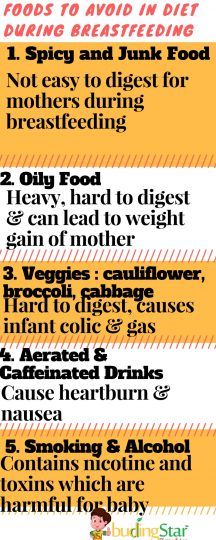
Now that we know what food is to be included and avoided, here is the Indian Diet Plan for Breastfeeding Mothers for your reference.
The Breastfeeding period can be alienated in 3 stages as below:
Stage 1. First 40 days (post-delivery)
Stage 2. After 40 days to 6 months (Remaining exclusive breastfeeding period)
Stage 3. Extended breastfeeding (ideally till 2 years)
Stage 1. Diet Plan for Breastfeeding Mothers for the First 40 Days:
Immediately after delivery, the next 40 days are very crucial for a mother and baby. Extra care should be taken as a mother experiences hormonal and physical changes in her body. Her body is healing; regaining strength and producing milk.
Indian Diet Plan for Breastfeeding Mothers :
| Food Items | CALORIE (KCAL) | PROTEIN (GMS ) | Tips and Nutri-fact | |
| Morning : 6:00-7:00 AM | ||||
| Herbal Tea/Milk | 100 | 5 | Herbal Tea increases the metabolism rate. Milk lowers the stomach’s acidic rush and improves digestion. | |
| Panjeeri (Small Half Bowl) | 200 | 10 | Proportion to make Panjeeri: Wheat and Nut ratio should be equivalent i.e. 1:1 ratio for better digestion and to avoid constipation. | |
| 8:30 AM | ||||
| Soaked Almonds (10) | 100 | 8 | Rich in Protein | |
| Breakfast: 09:00 AM | ||||
| Porridge/Upma/Stuffed roti (without oil)/Oats with milk/Cheese Sandwich/Bread Omlette | 300* | 10-15 | *The mentioned intake of protein & cal should be there in breakfast as this much amount is required by Breastfeeding mothers. | |
| 11:00 AM | ||||
| Non- Citrus Fruits such as Apple, Pomegranate | 40 | Provides Roughage for healthy bowel | ||
| Lunch: 1:00-2:00 PM | ||||
| 450 | 16 | Green veggies help in better digestion & lentils increases the protein content and breast milk. If you consume paneer in your diet then lentils should be avoided as simultaneously two variants of protein will increase calorie intake which is not advisable. | |
| 4:00 PM | ||||
| Herbal Tea/Milk with 2 Atta Biscuits | 100 | 2 | ||
| 6:00 PM | ||||
| Clear vegetable soups (green veggies/spinach/ tomato) | 100 | 2 | Contains iron and folic acid to recover blood loss during delivery and increase milk production. | |
| Dinner: 8:00-9:00 PM | ||||
| Chapati/Rice with Green veggies (1 Bowl) & Lentil (1 bowl) | 450 | 15 | Take jaggery after dinner to increase iron absorption. | |
| 10:00 PM | ||||
| 1 glass of milk | 100 | 2 | Increases milk production during night time and is good for sound sleep. | |
Important Tips:
- Continue with Folic acid (500 mcg) daily.
- Take Ajwain water after half an hour of meals for healthier digestion.
- Walk for at least 10-15 minutes daily at home only after lunch and dinner.
Note: The Indian Diet plan for breastfeeding mothers is framed to just give you an idea about the food items that you can include. You can make changes in timings and according to your acceptability for that food item.
Stage 2. Diet Plan for Breastfeeding Mothers after 40 days till the baby is 6 months old:
Once baby turns 5 months old:
- You can have all kinds of beans, potatoes, citric fruits, idli/dosa made up of well–fermented batter, onion, and even moderate black pepper. Such introduction of foods in the diet will enable the baby’s digestive system to be ready for direct solids as you can start feeding solids once the baby turns 6 months old.
- All the extra breakfast or snacks can be skipped slowly now.
*At this stage don’t just rush in for weight loss as it may affect breast milk production and your health too. Remember Moms…. Exclusive Breastfeeding helps in natural weight loss….!!
Stage 3. Diet Plan for Breastfeeding Mothers after 7 months till the baby is 2 years old:
From now onwards, there is no restriction on the diet but it should be a healthy one. You can now skip those extra snacks in between your meals. Now your baby is on solids too, so breast milk will be consumed less by him.
Vegetarian diet plan for breastfeeding mothers:
An alternative diet chart for breastfeeding mother that you can follow which has a combination of different foods that you should include in your mealtimes.
| Food Items | CALORIE (KCAL) | PROTEIN (GMS ) | Tips and Nutri-fact |
| 8:00 AM | |||
| Dried fruits | 150-200 | 8 | Rich source of minerals and can help boost a baby’s immunity. |
| Breakfast: 09:00 AM | |||
| Poha, 2 slices of whole wheat bread, 1 glass of skimmed milk | 362 | 16 | |
| 11:00 AM | |||
| Apple, Grapes, Oranges | 52-60 | Rich in Vitamin C | |
| Lunch: 1:00-2:00 PM | |||
| 2 chapati, 1 serving of vegetables, 1 cup of salad, 1 cup of rice, and 1 glass of raita | 347 | 19.6 | Veggies are a rich source of more vitamins and nutrients and can replenish the amount of nutrients that are needed while making milk. |
| 4:00 PM | |||
| A glass of milk with 4-5 crackers | 162.3 | 7.8 | |
| Dinner: 8:00-9:00 PM | |||
| 2 chapatis, 1 of serving rice and 1 serving of green leafy vegetables | 328 | 13.6 | Green leafy vegetables are rich in iron, calcium, and other minerals that help in an increase in lactation. Avoid highly processed food and caffeine intake in your meals. |
| 10:00 PM | |||
| 1 glass of milk | 100 | 2 | Helps enhance your sleep and provides the nutrients your baby needs. |
Small Tips:
- It is important to walk for 20-30 minutes every day to keep you fit and for proper digestion. You can walk at home only.
- Burping your baby is as important as feeding your baby. Try Burping your baby before switching breasts. Two common positions you can follow for burping: over your shoulder or sitting on your lap.
- Take at least 8 hours of sleep every day. It is difficult to complete the sleep with the baby but try to sleep in the afternoon or any time when your baby is also asleep.
- If in case of any digestion issues in mothers or babies that are too cranky (cries a lot), then consult your gynaecologist or paediatrician.
| [icon type=”icon-lamp”] Join our Facebook closed group called “Parenting Mom Style” only for Moms and To-be Moms to share experiences and queries. |
FAQs
1. What impact does your diet have on breastfeeding?
For the first six months, a baby completely depends on the mother’s breast milk for nutrition and hydration. A healthy diet for the mother ensures you are passing on essential nutrients to your baby. A breastfeeding mother needs to maintain a good diet rich in protein, calcium, iron, iron and Vitamin D. Follow a good vegetarian diet plan for breastfeeding mothers that gives you well-balanced meals encompassing all of these vital nutrients. Eating well during your breastfeeding period will help you with the extra nutrient needs that a new mom requires. It is better to eat regular balanced meals that have foods from all food groups with fresh vegetables and seasonal fruits.
2. Which fruits are most suitable for breastfeeding?
Ensure you are including enough fruits in the Indian diet for lactating mothers. You can include Indian seasonal fruits. Some of the fruits that can be added to a lactating mother’s diet chart are bananas, mangoes, sapota, and apricots. You could also include strawberries, blueberries, figs and cantaloupes if they are in season. Breast milk or feeding mother’s diet chart alone is like a superfood for babies because it carries all the essentials that a baby will need for its growth and development. These best fruits for lactating moms will ensure the baby is provided with essential nutrients, antioxidants, and vitamins throughout the first six months.
3. Do breastfeeding mothers require additional calories?
Breastfeeding mothers and lactating moms generally need more calories to meet their nutritional needs. Follow a vegetarian diet plan for breastfeeding mothers which allows an additional 330 to 400 kilocalories (kcal) per day that is recommended for well-nourished breastfeeding mothers.
Eating a well-balanced meal with fresh vegetables and fruits matters. You don’t need to pile up on your plate but a well-balanced nutrition-rich diet will help you and your baby. Mother’s milk is called the elixir which not only provides nutrition for the baby but also helps in their brain and bone development.
4. What Indian foods to avoid during breastfeeding?
We shortlisted some food items that you must avoid during pregnancy:
Foods that are spicy can irritate your baby’s tummy and result in gas or diarrhoea. It’s advisable to consume spicy foods in moderation and wait a few hours before nursing if you do.
Pregnant women may experience gas production from some foods, including beans, broccoli, and cabbage. These foods may cause gas in newborns, which may cause discomfort. It’s recommended to avoid certain foods from the lactating mother diet chart, if the mother finds that the baby gets gas after the consumption.
Caffeine can cause fussiness or irritability in newborns and can transfer through breast milk.
Indian foods such as asafoetida, curry leaves, mustard seeds, fennel, and turmeric may be best avoided during nursing. Their intense scents and tastes could be transferred to your infant through breast milk. Additionally, they may make newborns gassy.
5. Which Dal is good for lactating mothers?
Lentils or dal are high in Protein, minerals, and vitamins. They aid in the production of milk in addition to being high in nutrients. It has been suggested that red lentils (masoor dal) and yellow lentils (moong dal) operate as “galactagogues” or agents that secrete milk so you must add lentils to the lactating mother diet chart. While beans, such as kidney beans, peas, and chickpeas, are nutritious and widely consumed by nursing mothers worldwide, doctors in India typically advise against giving them to their patients since they increase the baby’s risk of colic.
6. Which Indian food increases breast milk?
Fruits like pineapple, figs, dates, apricots, and grapes are great sources to boost the production of milk in lactating mothers. They have a good source of nutrients required for the production of milk. Indian vegetables like carrots and beetroot have beta-carotene which is essential for breast milk. They also deliver nutrients and irons. Lentils are a great source of protein and minerals. The Indian OG dish khichdi is made of lentils. You must add it to your milk for good production of milk to breastfeed.
Happy Parenting!
You may be interested in reading –
- Home Remedies For Glowing Skin - March 13, 2022
- Healthy Foods for Kids – Junior Athletes - January 19, 2021
- Pregnancy Diet - January 14, 2021
- Natural and Herbal Remedies for Cold and Cough for Kids - August 13, 2017
- “DARR, DARE AND CARE”…. - July 30, 2017
- Nature’s Miracle – Benefits of “Camphor” - July 9, 2017
- Indian Diet Plan for Breastfeeding Mothers - July 2, 2017
- Zero Oil Cooking Recipes For Moms - June 25, 2017



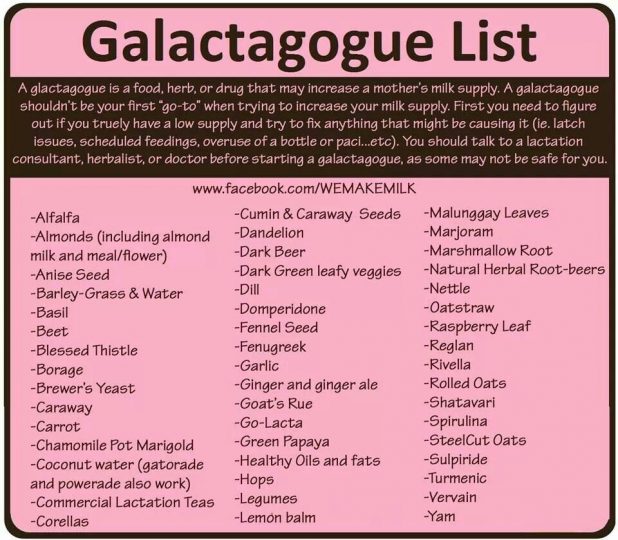












awesome site
and post is great wat i needed
Thanks to give awesome blog
Thankyou so much this blog was very nice.